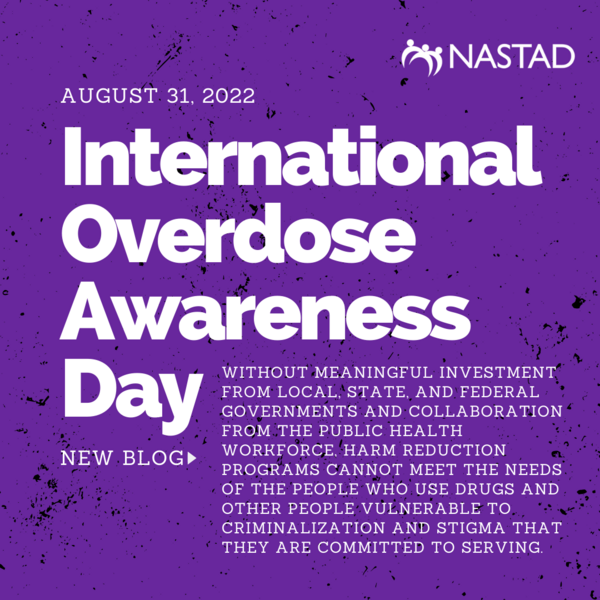
International Overdose Awareness Day 2022
Today, we at NASTAD, along with harm reductionists worldwide, are commemorating International Overdose Awareness Day (IOAD). When overdose deaths skyrocketed amid the COVID-19 pandemic in 2020, it was hard to imagine that the catastrophic loss of lives among people who use drugs could become any higher. But today marks the third International Overdose Awareness Day since the pandemic began and overdose death rates in the US have continued to reach unprecedented levels ever since.
Through the harm reduction principles we saw applied during the COVID-19 pandemic, our community can now safely come together in person to commemorate IOAD and honor the lives of those we have lost to the senseless War on Drugs. However, the comfort of physical safety from COVID-19 only extends so far when that same privilege of health, wellness, and life is consistently denied to people who use drugs (PWUDs). We know what works to save the lives of PWUDs and what the harm reduction community can achieve. But without meaningful investment from local, state, and federal governments and collaboration from the public health workforce, harm reduction programs cannot meet the needs of the people who use drugs and other people vulnerable to criminalization and stigma that they are committed to serving.
Staff, volunteers, and participants at harm reduction programs and syringe services programs (SSPs) work together to help keep people who use drugs alive and healthy and have been doing so for decades. Many harm reduction programs across the country continue to expand the services they offer, whether that may be drug checking or access to hepatitis B vaccination. Harm reduction programs are not only constantly expanding services to address the needs of the whole person, but they do so on limited budgets that are expected to meet the needs, at minimum, of their local community but often care for whole states or broader regions. Moreover, we know that even beyond the access to health care that harm reduction programs provide, they are often the only places PWUDs are treated with respect and empathy, without the fear of stigma, shame, and criminalization. It is hard to imagine that a healthcare program model, with such an extensive history of efficacy, cost-effectiveness, and improved community wellness, would be met with such bitter opposition and disinvestment if those benefitting were financially affluent, able-bodied, neurotypical, white, cisgender, or securely housed. Federal and state public health partners and other stakeholders must recognize harm reduction programs as the life-saving services they have proven themselves to be.
Overdose deaths are preventable. We know which tools and strategies are most likely to save lives and promote health. State and local health departments need to fully support community-led harm reduction programs as part of their public health infrastructure. Increased federal investment, addressing the full range of needs of PWUD and their communities, should be informed by and responsive to people who use drugs and communities affected by the War on Drugs. The investment required includes more than just increased funding for naloxone and supply distribution, but also housing options for people in active use, access to real-time drug-checking technologies beyond fentanyl testing strips, decriminalization of drug and paraphernalia possession, lifting the federal syringe purchasing ban, and the prioritization and sustained funding of harm reduction as the evidence-based and person-centered public health strategy that it is.
On this day and every day, we invite you to join NASTAD in honoring and mourning the people we've lost and recommitting to doing everything we can, from federal advocacy and coordination to funding and support for programs on the ground, to keep our loved ones safe, healthy, and alive.